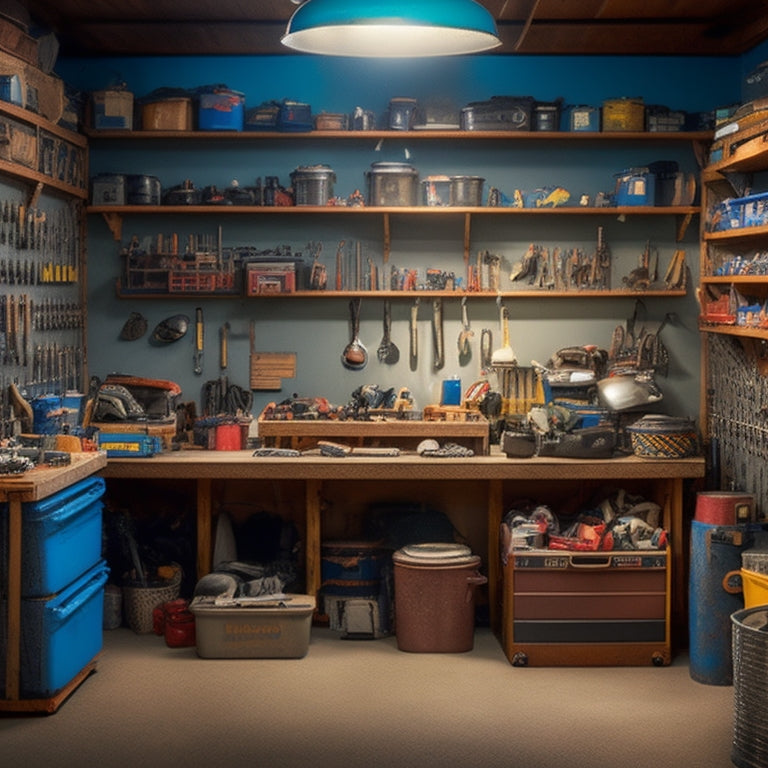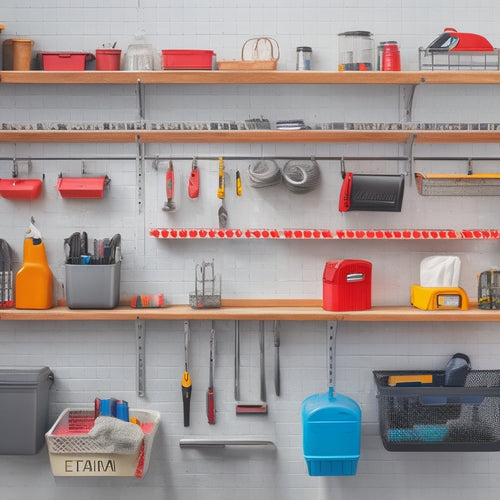
What's the Best Way to Store Tools in Tight Spaces?
Share
To store tools in tight spaces, you'll want to maximize your garage's vertical space with wall-mounted pegboards, hooks, or slatwall panels. Utilize ceiling hooks for hanging bikes or tools, and consider compact storage containers that can be stacked or mounted on walls. Optimize your workbench with zones for different tasks and tools, and make the most of corner space with carousel tool holders or corner shelves. Choose multi-functional tools to reduce clutter, and don't forget to label and categorize your tools for easy access. With these strategies, you'll be well on your way to a more organized and efficient workspace - and there's still more you can do to take it to the next level.
Key Takeaways
• Maximize vertical space with wall-mounted pegboards, hooks, or slatwall panels to store tools and accessories.
• Utilize compact storage containers and label them for quick identification to store smaller tools and accessories.
• Opt for multi-functional tools that serve multiple purposes to reduce the overall number of tools needed.
• Install carousel tool holders or corner shelves to make the most of corner space and store more tools in a smaller footprint.
• Allocate specific zones for different tasks and tools on your workbench to optimize storage and accessibility.
Maximize Your Garage's Vertical Space
To make the most of your garage's limited footprint, consider installing wall-mounted pegboards, hooks, or slatwall panels that allow you to hang tools, bins, and accessories, freeing up valuable floor space. This will create a more organized and efficient workspace.
You can also take advantage of your garage's ceiling by installing ceiling hooks to hang items like bikes, kayaks, or even tools with long handles.
Additionally, wall shelves can provide extra storage for less frequently used items, keeping them out of the way but still easily accessible.
For smaller items, consider using hanging baskets or bins that can be attached to the wall or ceiling. If you need to store heavier items or toolboxes, rolling carts with locking casters can provide a flexible and mobile storage solution.
Utilize the Power of Pegboards
With a pegboard, you can create a customized storage system that keeps your most frequently used tools and accessories within easy reach, freeing up valuable space and streamlining your workflow. This space-saving technique is perfect for tight spaces, as it allows you to hang tools on a wall or door, keeping them organized and accessible.
To get started, choose a pegboard that fits your available space, and then select hooks and bins that fit your tool organization needs. Consider the weight and size of your tools when selecting hooks, and choose bins with dividers to keep small items separate.
Once you've set up your pegboard, take a step back and admire your handiwork. You'll be amazed at how much space you've saved and how easy it's to find the tool you need. With a pegboard, you'll be able to quickly grab what you need, getting you back to work in no time.
Invest in Compact Storage Containers
You can further maximize your space by investing in compact storage containers that can be easily stacked or mounted on walls, providing a convenient and out-of-the-way storage solution for smaller tools and accessories. These containers come in various shapes and sizes, allowing you to choose the ones that best fit your specific needs.
Portable toolboxes, for instance, are ideal for storing handheld power tools, while magnetic tool holders can keep frequently used items like screwdrivers and pliers within easy reach.
When selecting compact storage containers, consider the materials they're made of and how durable they are. Look for containers with secure lids or compartments to prevent tools from getting mixed up or damaged. Additionally, think about the labels or signs you can use to identify what's stored in each container, making it easier to find what you need quickly.
Optimize Your Workbench Storage
Organizing your workbench storage means allocating specific zones for different tasks and tools, keeping essential items within easy reach to streamline your workflow. This will help you work more efficiently and reduce clutter.
Consider using portable toolboxes or magnetic tool holders to store frequently used tools, keeping them organized and accessible. For larger or heavier tools, consider investing in rolling tool carts that can be easily moved around your workspace.
Maximize your wall space by installing wall-mounted tool racks, which can hold a variety of tools and supplies. This will help keep your workbench clear and create more room for projects. Label each zone and storage container so you can quickly find what you need.
Make the Most of Corner Space
Corner spaces, often wasted areas in many workshops, can be converted into valuable storage zones by installing carousel tool holders or corner shelves that swing out for easy access. You can also consider wall-mounted solutions, such as pegboards or hooks, to hang frequently used tools within easy reach.
For a more customized approach, try DIY tool organizers like repurposed pallets or crates to create a corner shelving system that fits your specific needs.
To maximize corner space, consider sliding drawer systems that can be installed in tight spaces. These systems allow you to store small tools, fasteners, or accessories in compact, easy-to-access drawers.
When choosing a corner storage solution, think about the types of tools you need to store and the frequency of use. This will help you determine the best layout and configuration for your corner space. By making the most of this often-wasted area, you'll be able to store more tools in a smaller footprint, freeing up space for other important tasks.
Choose Multi-Functional Tools
Opting for multi-functional tools can further streamline your workshop's storage capacity, allowing you to store fewer, yet more versatile, tools in the space you've optimized. By choosing tools that serve multiple purposes, you'll reduce the overall number of tools you need to store, freeing up valuable space for other essential items.
For instance, consider investing in a portable drill that can also function as a screwdriver or a wrench. These versatile tools won't only save you space but also make your tool organization more efficient.
When selecting multi-functional tools, look for space-saving options that can perform a variety of tasks. A cordless multi-tool, for example, can be used for cutting, grinding, and sanding, making it an excellent addition to your workshop. Additionally, consider tools with adjustable handles or detachable heads, which can be easily stored and rearranged as needed.
Label and Categorize Your Tools
Assigning a home to each tool by labeling and categorizing them according to their function, frequency of use, or type is crucial for efficient tool organization. This step greatly improves your toolbox efficiency. By labeling and categorizing your tools, you'll be able to:
- Identify the tool you need at a glance, saving you time and reducing frustration
- Store similar tools together, making it easier to find what you need
- Keep track of your tools and prevent loss or misplacement
Proper tool identification is key to effective storage solutions. When you can quickly identify the tool you need, you'll be able to complete tasks more efficiently and provide better service to others.
Frequently Asked Questions
How Do I Prevent Tools From Getting Rusty in Storage?
While you're busy helping others, don't let rust hold you back! To prevent tools from getting rusty in storage, you'll want to focus on rust prevention and tool storage, ensuring moisture control and organized spaces that keep your tools dry and ready.
Can I Store Tools in a Humid Basement or Garage?
You can store tools in a humid basement or garage, but you'll need to prioritize humidity control and organization. Invest in a dehumidifier, install garage shelving, and utilize tool racks to keep your tools protected and accessible.
Are There Any Safety Concerns for Storing Power Tools?
When storing power tools, you'll want to address you're addressing safety concerns. Regular power tool maintenance and proper tool organization are key to preventing accidents and prolonging tool lifespan.
How Often Should I Clean and Maintain My Tool Storage?
Just like a gardener tends to their garden, you should regularly clean and maintain your tool storage to prevent rust and damage. Aim for a monthly cleaning frequency, and adjust your maintenance schedule based on storage location and humidity levels.
Can I DIY My Own Tool Storage Solutions Instead of Buying?
You can DIY your own tool storage solutions, focusing on space optimization with creative solutions. Try upcycling or repurposing materials like old pallets, crates, or containers to create functional and customized storage systems that fit your needs.
Related Posts
-

Best Screw Storage Bins for Organizing Your Toolbox
You need a reliable screw storage system to maximize your productivity and efficiency, and that's exactly what the ri...
-

3 Simple Steps to a Garage Tool Wall You'll Love
To create a garage tool wall you'll love, start by planning the space, taking inventory of your tools, and measuring ...
-

Best Tool Hooks for Garage Organization
When choosing the best tool hooks for your garage organization, you'll want to evaluate factors like weight capacity,...


